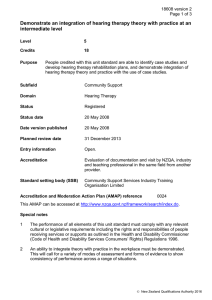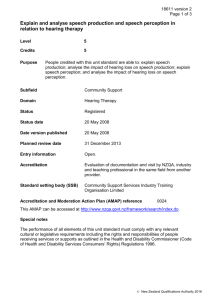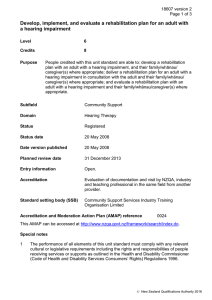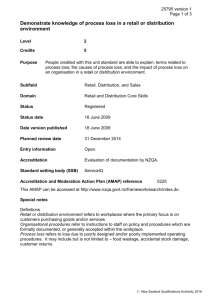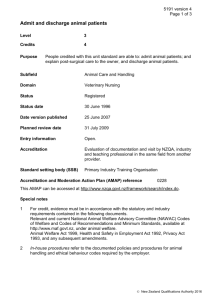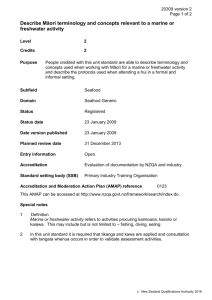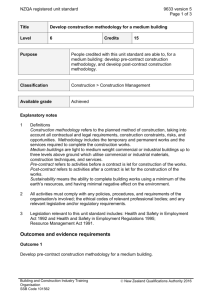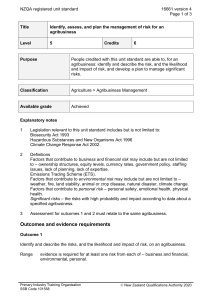18609 Demonstrate an integration of hearing therapy theory
advertisement
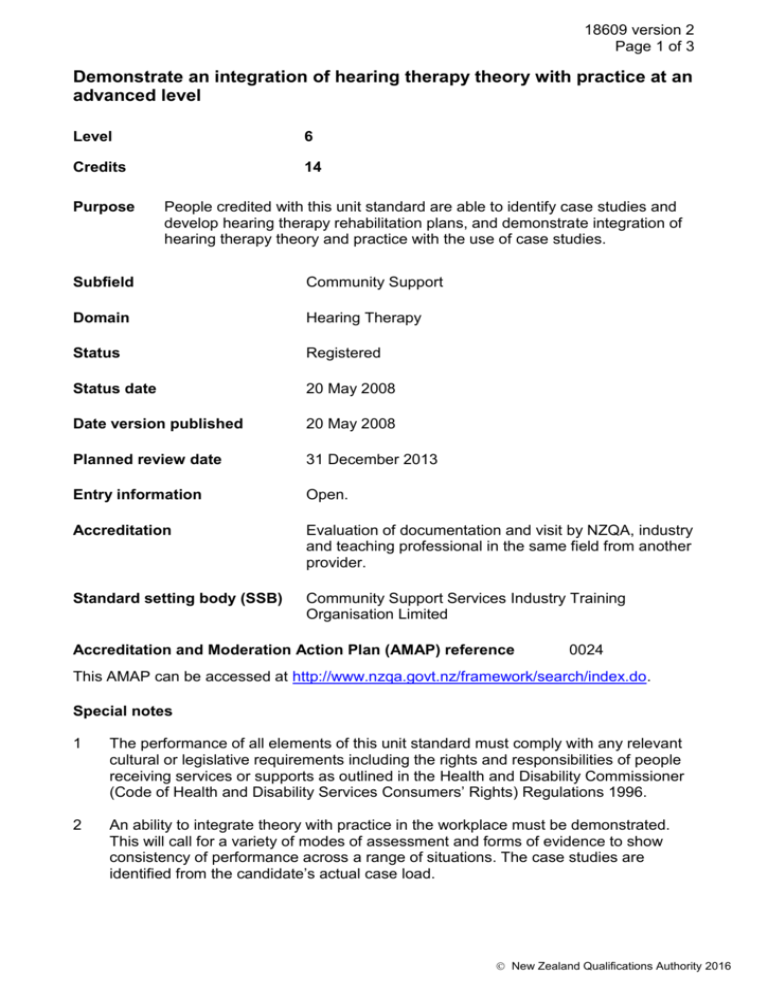
18609 version 2 Page 1 of 3 Demonstrate an integration of hearing therapy theory with practice at an advanced level Level 6 Credits 14 Purpose People credited with this unit standard are able to identify case studies and develop hearing therapy rehabilitation plans, and demonstrate integration of hearing therapy theory and practice with the use of case studies. Subfield Community Support Domain Hearing Therapy Status Registered Status date 20 May 2008 Date version published 20 May 2008 Planned review date 31 December 2013 Entry information Open. Accreditation Evaluation of documentation and visit by NZQA, industry and teaching professional in the same field from another provider. Standard setting body (SSB) Community Support Services Industry Training Organisation Limited Accreditation and Moderation Action Plan (AMAP) reference 0024 This AMAP can be accessed at http://www.nzqa.govt.nz/framework/search/index.do. Special notes 1 The performance of all elements of this unit standard must comply with any relevant cultural or legislative requirements including the rights and responsibilities of people receiving services or supports as outlined in the Health and Disability Commissioner (Code of Health and Disability Services Consumers’ Rights) Regulations 1996. 2 An ability to integrate theory with practice in the workplace must be demonstrated. This will call for a variety of modes of assessment and forms of evidence to show consistency of performance across a range of situations. The case studies are identified from the candidate’s actual case load. New Zealand Qualifications Authority 2016 18609 version 2 Page 2 of 3 3 Documentation must be presented for one case study for each of the following (total of 3 case studies: the maximisation of visual cues through development, implementation and evaluation of a speechreading programme; the maximisation of auditory cues through development, implementation and evaluation of an auditory training programme; and the teaching of communication strategies through environmental management, repair strategies and telephone skills. 4 Definitions Organisation’s policies and procedures are the policies and procedures of the employing organisation of the employee and include ethical codes, standards, and requirements of any other organisations involved. A theoretical base is defined as theory that is accepted in the sector and published by credible theorists. Examples of credible theorists and accepted theory can be found in the references listed below. 5 References Hull, Raymond H., Aural Rehabilitation: Serving Children and Adults, 4th Ed (San Diego, CA: Singular Publishing Group, 2000), is the primary reference for the following tests – Utley Speech Reading Test; Denver Quick Speechreading Test. Alpiner, Jerome G; and McCarthy, Patricia A, Rehabilitative Audiology: Children and Adults 3rd ed. (Baltimore: Williams and Wilkins, 1999), is the primary reference for the following tests – Quantified Denver Scale of Communication; California Consonant Test; Speech Perception in Noise Test (SPIN); Sanders Needs Communication Profile. Erber, Norman P, Communication Therapy for Hearing-Impaired Adults (Victoria, Australia: Clavis, 1988), is the primary reference for the following tests – Topicon; Sent-Ident; Erber’s Quest-AR. National Acoustics Laboratory (Australia) is the primary reference for the following tests – Client-Oriented Scale of Improvement (COSI) http://www.nal.gov.au/. Erdman, SA; Crowley, JM; and Gillispie, GG, Considerations in counselling the hearing impaired. Hearing Instruments, 35 (11) 1984, is the primary reference for the following test – Behavioural Inventory for Rehabilitation Therapy (BIRT). This is no longer published but candidates may access the reference through Careerforce, PO Box 25-255, Christchurch. Jeffers, Janet; and Barley, Margaret; Speechreading (Springfield, IL: Charles C Thomas, 1980), is the primary reference for the following test – Barley Speechreading Test. Weinstein, Barbara E; Geriatric Audiology (New York: Thieme, 2000), is the primary reference for the Hearing Handicap Inventory for the Elderly (HHIE). 6 Current best practice is documented in the University of Auckland, School of Medicine Master of Audiometry Programme pure-tone audiometry clinical protocols. These are available from Careerforce, PO Box 25-255, Christchurch. New Zealand Qualifications Authority 2016 18609 version 2 Page 3 of 3 Elements and performance criteria Element 1 Identify case studies and develop hearing therapy rehabilitation plans. Performance criteria 1.1 Case studies used to develop hearing therapy rehabilitation plans are identified and linked to a theoretical base. 1.2 Rehabilitation plans are developed in accordance with the identified theoretical base and current best practice in hearing therapy. Element 2 Demonstrate integration of hearing therapy theory and practice with the use of case studies. Performance criteria 2.1 Case studies incorporate the identified theoretical base, current best practice and relate to the organisation’s policies and procedures. 2.2 Case studies are documented in accordance with the organisation’s policies and procedures. Please note Providers must be accredited by NZQA, or an inter-institutional body with delegated authority for quality assurance, before they can report credits from assessment against unit standards or deliver courses of study leading to that assessment. Industry Training Organisations must be accredited by NZQA before they can register credits from assessment against unit standards. Accredited providers and Industry Training Organisations assessing against unit standards must engage with the moderation system that applies to those standards. Accreditation requirements and an outline of the moderation system that applies to this standard are outlined in the Accreditation and Moderation Action Plan (AMAP). The AMAP also includes useful information about special requirements for organisations wishing to develop education and training programmes, such as minimum qualifications for tutors and assessors, and special resource requirements. Comments on this unit standard Please contact the Community Support Services Industry Training Organisation Limited enquiries@cssito.org.nz if you wish to suggest changes to the content of this unit standard. New Zealand Qualifications Authority 2016
